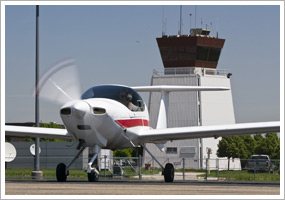| The following stories from the March 4, 2011, edition of AOPA ePilot were provided to AOPA members who expressed an interest in the particular subject areas. Any AOPA member can receive information tailored to their areas of interest by updating their preferences online. - My ePilot -- Helicopter Interest -Attention helicopter pilots: AOPA President Craig Fuller and other industry leaders will speak at the General Aviation Association CEO Forum at Helicopter Association International’s Heli-Expo 2011 in Orlando, Fla., March 6. Join them at 9:30 a.m. to find out more about the state of GA. For further details and to register, go online. training tipsAn instructive arrival After landing at an unfamiliar airport, the pilot received instructions to taxi to the end of the runway and turn left for the terminal. “Later the same day (while the same tower controller was on duty) I landed on the same runway with the same destination in mind. The controller said ‘Exit when able.’ Since he had cleared me earlier to the end of the runway, I again taxied to the end of the runway and in the process switched to ground frequency.” As the pilot approached the hold-short line, “the controller radioed and asked me if I was ‘on line.’ (Evidently he had tried to contact me on the tower frequency.) When I said I was he (politely) chewed me out for taking so much time to exit the runway and that other traffic was held up as a consequence.” Credit the controller for calling the errors to the pilot’s attention in a nonconfrontational manner that helped the pilot see the consequences of his actions. The term “when able”—also used in conjunction with departure instructions such as a turn to an assigned heading after takeoff—was discussed in the March 2, 2007, Training Tip. It appears in the Pilot/Controller Glossary and conveys a need for prompt compliance after a condition such as clearing an obstruction after takeoff is resolved. Study the glossary carefully. One of its valuable features is that it conveys “specific procedural expectations” of terms crucial to safety. When should a pilot switch frequencies from tower to ground control? The Dec. 10 Final Exam question addressed both issues confronted by this pilot, citing the Aeronautical Information Manual. “ Chapter 4-3-20 states that after landing and slowing to taxi speed, a pilot should exit the runway at the first available taxiway or at the taxiway instructed by ATC.” On switching frequencies: “Also, keep your radio on the tower frequency until you are told to contact ground control.” Review the lessons of this instructive episode by taking the Air Safety Institute ATC Terminology Safety Quiz, honing your skill in ground operations and communications. You may also wish to review the online Say It Right course for an overall look at radio terminology.training productsiPad GPS with BluetoothThe GNS 5870 MFI is an Apple-approved GPS for use with the iPad, iPhone, and iPod Touch. The unit’s Bluetooth capability means it connects to your iPad wirelessly and lets you run such apps as Foreflight or WingX with a moving-map display. The unit’s rechargeable battery is said to last 10 hours. It sells for $129.95 from Sporty’s Pilot Shop. Note: Products listed have not been evaluated by ePilot editors unless otherwise noted. AOPA assumes no responsibility for products or services listed or for claims or actions by manufacturers or vendors. final exam
Question: How does weight affect takeoff and landing performance?
Answer: How much an airplane weighs at takeoff or landing can certainly have a significant impact on performance. A heavier airplane will use more of the available runway length while accelerating to a safe take-off speed. The greater mass takes more time to get moving and in turn eats up valuable real estate. Landing distance also increases as the weight of an airplane increases because a higher speed is required to support the airplane at the landing angle of attack. More weight also means less climb performance, higher fuel consumption, and reduced range. For more on the topic, read the safety article “ Calculating Weight and Balance in Advance.”
Got a question for our technical services staff? E-mail [email protected] or call the Pilot Information Center, 800/872-2672. Don’t forget the online archive of “Final Exam” questions and answers, searchable by keyword or topic. |
 A pilot related a recent learning experience that challenged his knowledge of towered-airport procedures in the
A pilot related a recent learning experience that challenged his knowledge of towered-airport procedures in the 

